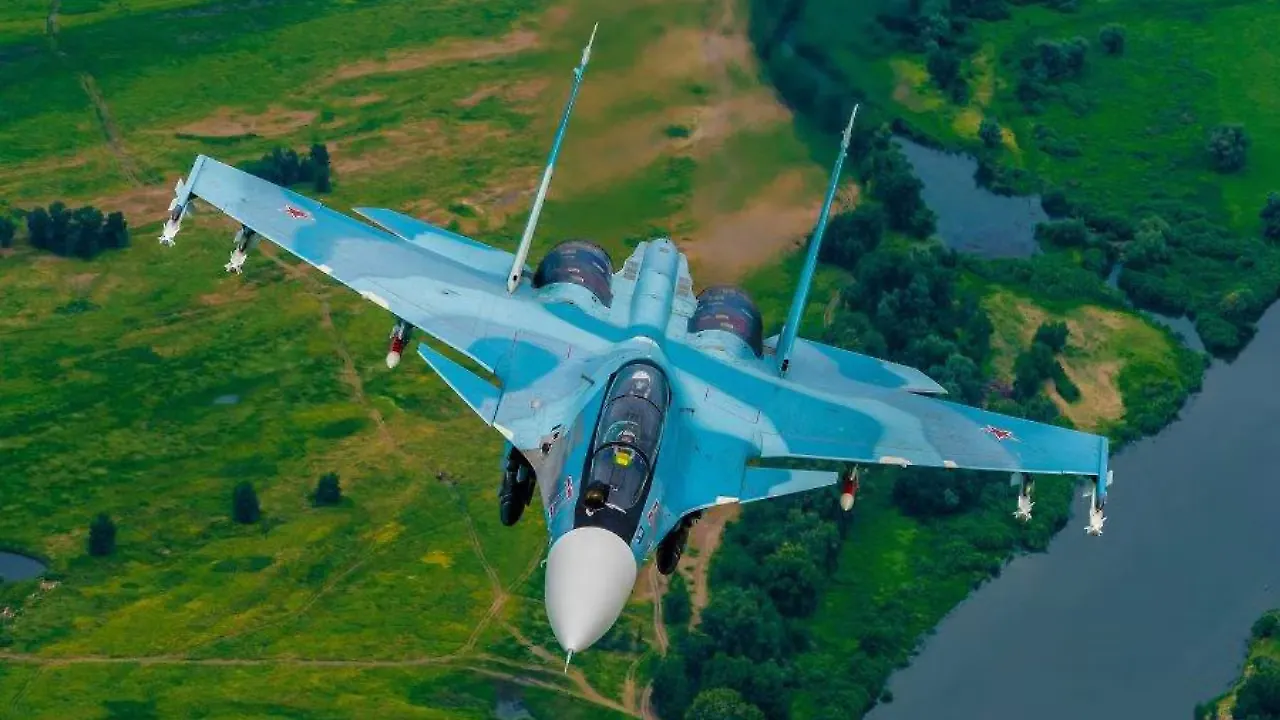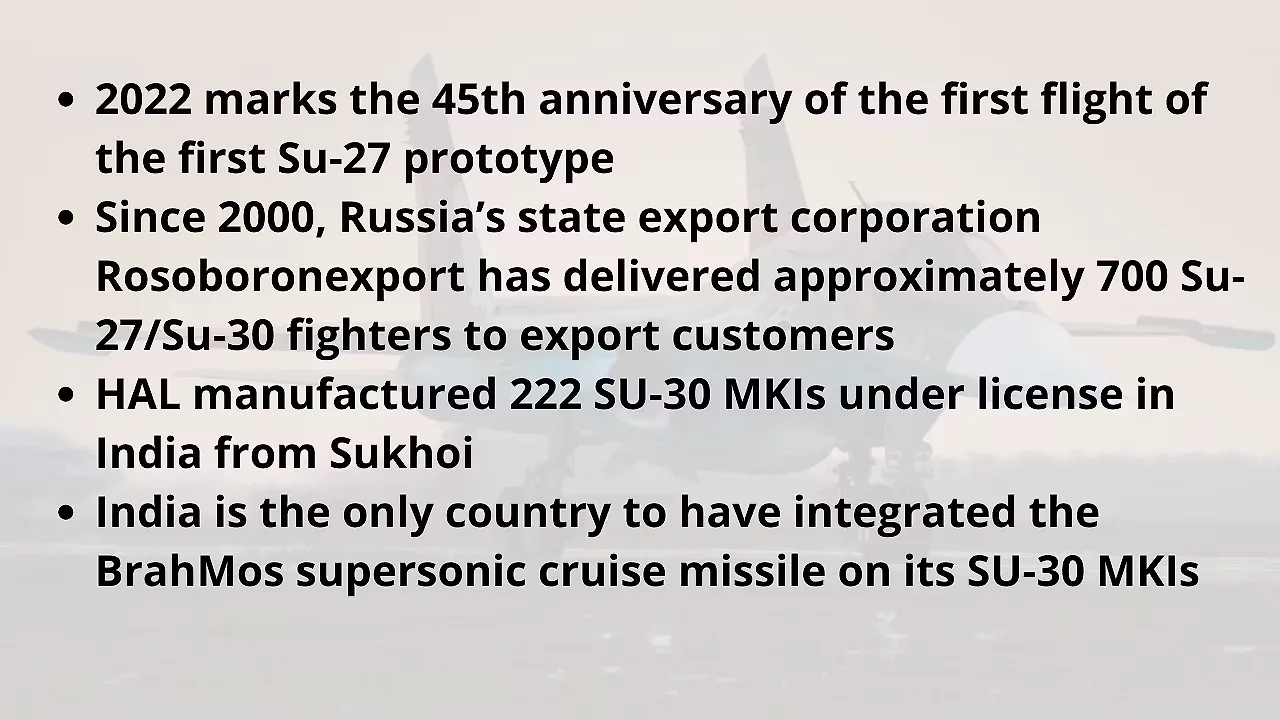
The famed Russian Sukhoi Experimental Design Bureau is celebrating the 45th anniversary of the maiden flight of the first Su-27 fighter prototype. The twin-engine fighter type, which first flew in 1977 as the T-10, was redesigned and became one of the most famous Russian fighter aircraft ever designed. Its variants will remain in widespread service till 2040 and beyond.
The Su-27 family spawned the Su-30, Su-34 bomber and newer Su-35 fighter aircraft. Vladimir Artyakov, First Deputy Director General, Rostec State Corporation, said, 'Air superiority is a key factor in any confrontation. That is why we pay great attention to developing new advanced platforms. At one time, the Su-27 became a technologically breakthrough machine and the progenitor of a whole family of outstanding aircraft: the Su-30, Su-34 and Su-35.'
Export Success
The Su-27 and twin-seat Su-30's combat performance made them customers in Angola, Belarus, Venezuela, Vietnam, India, Indonesia, Kazakhstan, China, Malaysia, Uganda and other countries. India operates over 300 Su-30 MKIs, and the latest versions now offered for export by Sukhoi are the Su-30SME, Su-34E and Su-35, which are considered 4+/4++ generation aircraft. Since 2000, Russia’s state export corporation Rosoboronexport has delivered approximately 700 Su-27/Su-30 fighters to export customers. It also received orders from the Russian Air Force in 2021 for Su-30SMs.
'Over the past ten years, the share of aircraft supplies in Russia’s total arms exports has stood at 40-50%, and even exceeds this figure today. Currently, our partners highly appreciate that engines, avionics, weapons, systems and components in Russian combat aircraft are exclusively Russian-made. This ensures the independence of the purchasing countries from unfair actions taken by third countries,’ said Alexander Mikheev, Director General of Rosoboronexport (part of Rostec State Corporation).

Latest Variants
Russia is the largest operator of Sukhoi combat aircraft and operates the latest variants of the Su-27 family in the Su-30SM and Su-35 aircraft, which can effectively intercept air targets and attack military installations with precision-guided weapons from low, medium and high altitudes. The Russian Knights and Falcons of Russia aerobatic teams also operate Su-27/Su-30/Su-35 fighters.
The Su-35 is also offered for export by Sukhoi as a 4++ generation aircraft, and it can perform an entire range of fighter missions over a wide altitude and speed envelope. It can carry up to 12 medium-range air-to-air guided missiles or six air-to-surface missiles in one sortie, while its powerful onboard radar can detect aerial targets up to 350 km away.
Prime Operator
One of the most notable foreign operators of Su-30 type fighters is India, where it is a frontline all-weather aircraft with multi-role capability, which can undertake varied air combat and ground attack missions. The Su-30 MKI also introduced thrust vectoring capability into the Indian Air Force (IAF). Su-30 MKIs delivered to India, fitted with a phased-array radar, were the first instance of export of such a radar system. In addition to its excellent performance and handling characteristics, the Su-30 MKI had 12 hard points on which it could carry weapons and sensors weighing up to eight tonne. A Su-30 MKI could travel up to 8,000 km with two mid-air refuellings.
The Government of India approved the acquisition of 40 Su-30 fighter jets (8 Su-30K and Su-30MK) and associated equipment for INR 6310 crore in 1996. The Su-30K was the export version of the basic Su-30. The eight Su-30K fighter jets were delivered in 1997, following which an additional 10 Su-30 MKs were ordered in 1998 in a contract worth INR 1,187 crore. The first ten units were inducted into the IAF in September 2002.
The Su-30 MKI programme was also notable for incorporating a significant number of systems demanded by the air force, which was achieved by the Defence Research & Development Organisation (DRDO) and Hindustan Aeronautics Ltd (HAL) under ‘Project Vetrivale.' The India-specific systems installed on the Su-30 MKI included key avionics systems such as the mission computer, display processor, radar computer, Radar Warning Receiver (RWR), etc.
Future Plans
HAL manufactured the Su-30 MKI under license from the Sukhoi Design Bureau and, between 2000 to 2012, received orders for the production of 222 aircraft at Nasik. These orders for 222 aircraft were worth approximately INR 65,000 crore, and with production now complete, HAL is focusing on the SU-30 MKI overhaul and the pending upgrade of SU-30 MKIs.

HAL has established a state-of-the-art MRO facility to overhaul Su-30 MKI aircraft and its aggregates at Nasik, Hyderabad, Lucknow and Korwa. The first aircraft, after overhaul, was handed over to the IAF in 2014-15. HAL is now awaiting a final order for 12 Su-30 MKIs.
There is also a proposal to upgrade existing IAF Su-30 MKIs to improve their combat efficiency and combat potential. The aircraft are planned to be upgraded with advanced Indigenous, Russian and Western systems. The major systems planned to be upgraded include the radar, weapon control system, in addition of new missiles, Mission Computer, communication suite etc.
HAL also played a key role in integrating the BrahMos Air Launched Cruise Missile on the SU-30 MKI and clearing the Astra BVRAAM on the SU-30 MKI. BrahMos integration on Su-30MKI was fully completed in 2019, and HAL carried out the complex mechanical and electrical modifications that needed to be done on the airframe. The air launched BrahMos missile is a 2.5-tonne supersonic air-to-surface cruise missile with ranges close to 300 km.